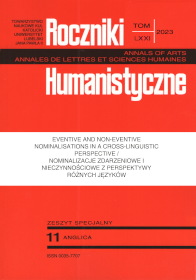The Structure of r-Nominals in -nie/-cie in Polish and the Factors Conditioning Their Emergence
The Structure of r-Nominals in -nie/-cie in Polish and the Factors Conditioning Their Emergence
Author(s): Maria Bloch-TrojnarSubject(s): Language and Literature Studies, Theoretical Linguistics, Morphology
Published by: Towarzystwo Naukowe KUL & Katolicki Uniwersytet Lubelski Jana Pawła II
Keywords: R-Nominals; deverbal nominals; argument licensing; AspectP licensing; Polish
Summary/Abstract: The aim of this paper is twofold: to establish the structure of deverbal nominals in -nie and -cie which lack argument structure and function as Simple Event and Result nominals, and to specify the factors conditioning their emergence. The proposed analysis is framed in Borer’s exo-skeletal model supplemented by elements of the nanosyntactic approach. The Polish data are puzzling since R-nominals in -nie/-cie show morphological evidence of the verbalising layer in the guise of a theme element alongside aspectual marking. The proposed account includes the aspectual projection of inner aspect in their structure and argues that the licensing of the internal argument is not related to the presence of verbalising morphology or of the inner aspect projection, which in the case of Polish can be multi-layered.. For an R-nominal to emerge, the structure must not contain the projection of viewpoint aspect responsible for the licensing of the full argumental complex. The presence of the VP layer accounts for the ambiguity between simple event and concrete reading. A stem-based R-nominal will arise if there is no root-based R-nominal, e.g. (s)kaleczyć ‘hurt’ —*(s)kalecz—skaleczenie ‘wound’ vs. (po)dzielić ‘divide’—podział ‘division’. Only R-nominals in -nie and -cie will be possible where the presence of an overt verbaliser with a root merged with a nominal or adjectival functor blocks the formation of root-based nominals, e.g. łysy ‘bald’—(wy)łysieć ‘go bald’—wyłysienie ‘a bald patch’—*(wy)łys.
Journal: Roczniki Humanistyczne
- Issue Year: 71/2023
- Issue No: 11S
- Page Range: 43-76
- Page Count: 34
- Language: English

